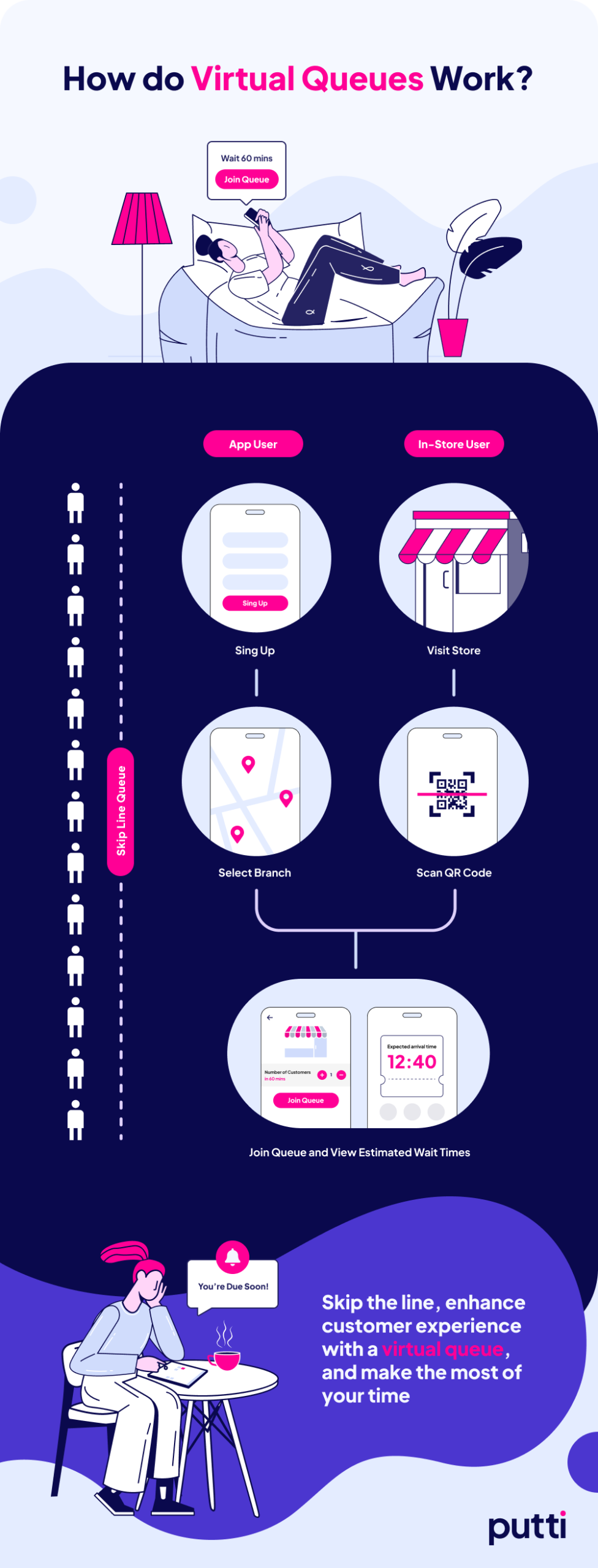Virtual queuing is a rapidly growing technology that is quickly becoming the go-to solution for businesses of all sizes. By allowing customers to wait in line virtually, businesses can improve the customer experience, increase efficiency, and boost profits.
In a previous post, we delved into the impressive benefits of virtual queuing and examined its increasing adoption across industries.
We’d love for you to know how this amazing technology works, -and today we aim to delve deeper into the inner workings of this transformative technology. Let’s take a look at the intricate mechanics behind virtual queuing and shed light on its functionality.
How Virtual Queuing Works
A virtual queuing system typically consists of the following components:
- A queue management software
- A queue display
- A notification system
The queue management software is responsible for tracking the number of customers in line and their position in the queue. The queue display is used to show customers where they are in line and how long they have to wait. The notification system is used to notify customers when it is their turn to be served.
Virtual queuing systems typically work in one of two ways:
Web-based systems: Customers visit a website and enter their contact information and the reason for their visit. They are then assigned a virtual queue number and notified when it is their turn to be served.
App-based systems: Customers download an app and create an account. When they arrive at the business, they scan a QR code or enter their phone number to join the virtual queue. They are then notified when it is their turn to be served.
This infographic provides a visual representation of the virtual queuing process:

Benefits of Virtual Queuing
Virtual queuing offers a number of benefits for businesses, including:
Improved customer experience: Customers no longer have to stand in line, which can be a frustrating and time-consuming experience. With virtual queuing, customers can wait in line from anywhere on their own time.
Increased efficiency: Virtual queuing systems can help businesses to manage their capacity better and improve the flow of customers through their business. This can lead to shorter wait times, increased productivity, and improved customer satisfaction.
Boosted profits: Virtual queuing can help businesses to boost profits by increasing customer spending and reducing the number of abandoned carts.
Challenges in Implementing Virtual Queuing
While virtual queuing undoubtedly offers a multitude of advantages, it is important to acknowledge that its implementation does not come without challenges.
The cost of implementing a virtual queuing system can be a concern for businesses, particularly smaller establishments with limited budgets. The technology required to integrate virtual queuing into existing operations seamlessly may entail upfront expenses, such as acquiring compatible software and hardware, setting up the necessary infrastructure, and training staff members. However, it is crucial to view these costs as an investment rather than an expenditure. The long-term benefits of improved customer experience enhanced operational efficiency, and increased customer loyalty often outweigh the initial financial outlay. Additionally, as virtual queuing becomes more prevalent, the market is witnessing a gradual decrease in associated costs, making it a more viable option for businesses of varying sizes.
Businesses must also address the potential resistance from customers who are accustomed to traditional queuing methods. Change, especially in well-established routines, can elicit scepticism and apprehension. Some individuals may prefer the tangible aspect of physically standing in a line, as it provides a sense of order and visual confirmation of their position. Overcoming this resistance requires effective communication and education about the benefits of virtual queuing. Demonstrating the ease of use, time-saving advantages, and personalised features can help assuage concerns and encourage customers to embrace this modern approach. Furthermore, offering alternative options for those who may still prefer traditional queuing, at least during the initial transition period, can help mitigate resistance and ensure a smooth adoption process.
While these challenges should not be disregarded, it is important to recognise that they can be overcome with thoughtful planning and strategic implementation. As technology continues to evolve, businesses must adapt to meet their customers’ ever-changing demands and expectations. Virtual queuing presents an opportunity to revolutionise the customer experience, improve operational efficiency, and stay ahead of the competition. By addressing the cost concerns and proactively managing customer resistance, businesses can successfully navigate the path towards a seamless and enhanced queuing experience for all parties involved.
Virtual queuing stands as an exceptional tool for elevating the customer experience to unprecedented heights. Its user-friendly nature and adaptability across diverse environments make it a versatile solution for businesses of all kinds. By harnessing the power of virtual queuing, organisations can bid farewell to the limitations of traditional queues and embrace a future where waiting becomes a seamless, hassle-free experience.
Explore our virtual queuing solutions
Embrace the queue-less life and unlock a world of boundless possibilities. Take the plunge, seize the opportunity, and sign up now to savour the sweet gift of time.

